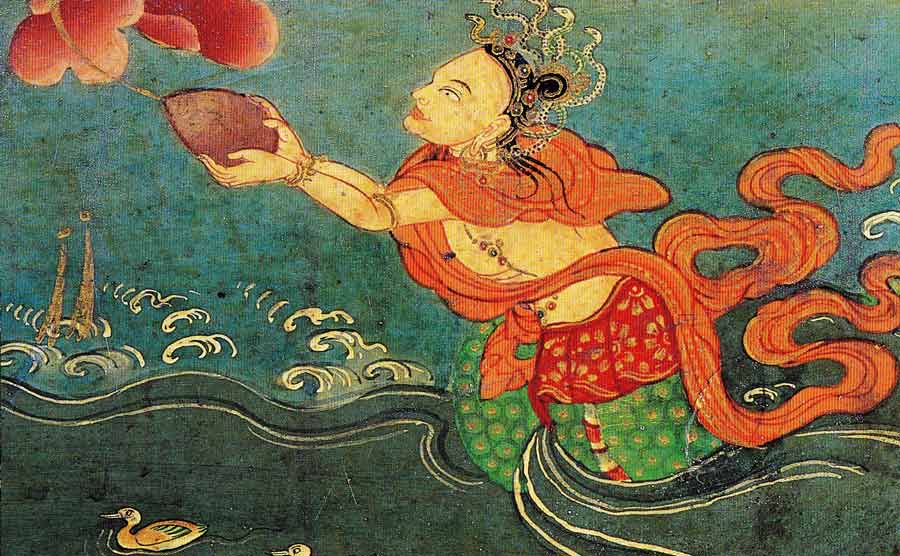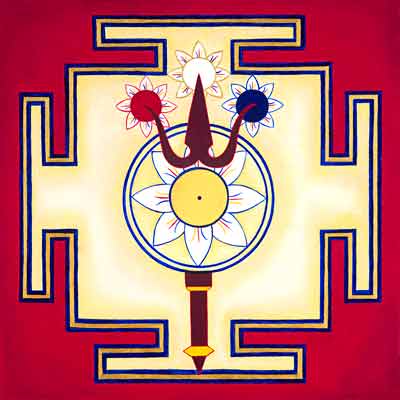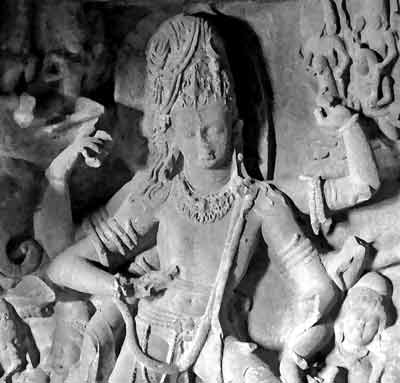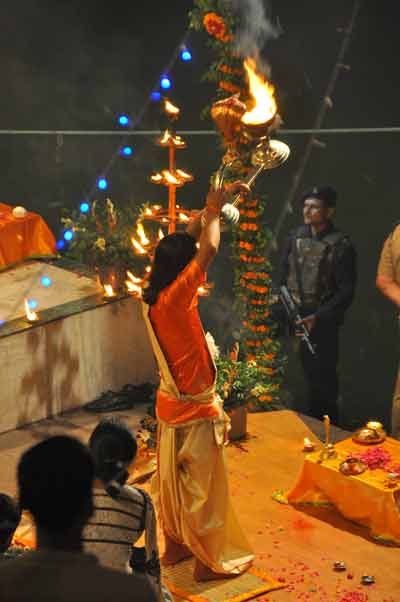
Offering
Everything is Consciousness:
It is the source of all life as well as the power of life itself.
The purpose of spiritual practice is to understand and directly experience this ultimate truth, and furthermore, to discover that we are that
Consciousness. In the nondual Kashmir Shaivite tradition of Anuttara Trika, this all-pervading Consciousness is called Śiva. He exists in a state of
eternal completeness, simply repeating,
Aham
, “I am.” That mantra expresses His divine status and it also gives life to us.
Aham
is the very breath of Śiva.
Kashmir Shaivism describes five essential powers of Śiva. The first is that of Consciousness itself. Then, emerging from within Śiva’s infinite
Consciousness is Śakti, the divine energy that creates, sustains, and dissolves the universe, again and again. Tantric exposition clearly states that this
power is inherent in the very nature of Consciousness itself. It is not an inert awareness. Śakti is the power of bliss, and arising from bliss are the
triadic powers of divine will, knowledge, and action.
Consciousness, bliss, will, knowledge, and action are the source of everything that exists, including our own individuated life. All of creation manifests
as an expression of Śiva’s unity, arising from within Himself through His five powers for the purpose of expanding His freedom and the joy of that freedom.
From within Śiva come all the energies that sustain and illuminate our experience and provide the means to discover our unity with our source. In our
sādhana, we learn to access our own divinity by aligning ourselves with these powers.
Śiva’s grace gives us the capacity to know unconditional joy by knowing Him as our Self. From the highest perspective, this means that Śiva can look back
at Himself through us. This is possible, because all reality, both inner and outer, is held within undifferentiated Consciousness in a state of absolute
potential. That Consciousness bursts forth as prakāśa, the light that illuminates life. Brilliant in its own radiance, this power is an effulgence that
continually shines forth from within itself to create all manifestation. The illuminating power of prakāśa is present in every level of creation,
experienced as infinite light in our own awareness. Although it appears as diversity, prakāśa is really the expression of unity, much as light
coming through a lattice is broken into parts.
The other essential aspect of Consciousness is vimarśa, the ability of Consciousness to be self-aware. Like a mirror, vimarśa is the self-reflective
capacity of infinite Consciousness to see the light and to recognize itself as the light. It does not depend on anything outside of itself to know itself.
Both prakāśa and vimarśa are inherent in God’s nature, and are another way of understanding Śiva and Śakti, the cosmic forces of
Consciousness and energy. These two are never separate because underlying the entire universe is a conscious energy. Prakāśa and vimarśa are the
all-embracing fullness of supreme Consciousness.
Śiva’s next three divine powers of will, knowledge, and action are traditionally referred to as goddesses. Parā is the supreme goddess of Śiva’s will, the
ultimate power of His intention to create. This power of will arises from bliss for the sole purpose of expanding Śiva’s own state of perfection, joy, and
freedom. Knowing this to be His purpose of creation, Śiva then, through the power of action, unfolds all of life, and through the power of knowledge knows
all of that life to be Himself. Tantric tradition therefore delineates that there are three aspects of the supreme goddess—Parā (will), Parāparā
(knowledge), and Aparā (action). They are all part of the one goddess who embodies the triadic energy of manifestation and the kunḍalinī śakti that creates
us as individuals. However, when we talk about the three goddesses or powers, we can never separate them. They are like a three-legged table. All three
legs must be there or the table is going to fall over. The three goddesses simply reflect the different ways that Śiva’s light shines forth.

Para Devi Trika Mandala Used In Initiation Ceremonies
As divine light shines back on itself, it reveals the face of God, which is none other than our own reflection. We can also speak of God as having five
faces, which are His five powers of Consciousness, bliss, will, knowledge, and action. Our capacity to see God comes from the ability to know ourselves, to
penetrate back through the emission of His powers to their source. And, like God, we do not depend on anything outside of ourselves to know who we are. We
have direct access to this highest knowledge, because it is contained within us.
In the words of the renowned, eleventh-century Kashmiri master Abhinavagupta:
The highest insight of Anuttara Trika is union with
śakti,
the triad of energies of will, knowledge, and action.
This is Śiva’s Trident, the three aspects of
His absolute nature and freedom,
which He possesses by virtue of His union with His own emission.
In the practice of Anuttara Trika,
the sādhaka penetrates the energy of emission, becoming one with Śiva,
the source and holder of the powers of the universe.
To understand this further, let’s look at the five faces, the five powers of Śiva, in more detail. These powers correspond to what Tantric traditions
refers to as the first five tattvas, or levels of Consciousness.
The highest tattva, cit śakti is the power of Consciousness itself. This is Śiva: infinite, omnipresent Consciousness, which is transcendental,
unmanifest, and formless, yet exists within and as everything that is created. Cit śakti is the source of all other powers, all other
energies, and ultimately all manifestation. We’ve said that Consciousness is a dynamic stillness. It is not an inert Presence because inherent within it is
the power to be aware. The reason it’s called cit śakti is because śakti means energy. This is the energy of Consciousness itself,
ever-present within our individuated consciousness.
The next level is ānanda śakti, the energy of bliss. The first thing that arises out of the power and awareness of Consciousness—before anything else
manifests—is the bliss of its own Self, the bliss of its own existence. The effulgence of this Consciousness is so powerful that it expresses pure,
unbounded, unconditional joy from the experience of its own fullness. How amazing to understand that as energy explodes out of Consciousness, it explodes
as joy and from joy. This offers us valuable clue about where we wish to point our attention as we work to penetrate through the manifest expression of
life back to its source.
The next three tattvas are Śiva’s powers of will, knowledge, and action. Will, or icchā śakti, lives as the goddess Parā. From within Śiva’s
experience of His own freedom and joy comes the will to perpetually expand that state. If divine will is the expansion of freedom, perfect in its
understanding and in its own bliss, then everything that emerges and manifests from it must also be perfect. Śiva knows Himself and exactly what He wants
to create in order to share His freedom and express His joy. That power of knowing is jñāna śakti, the goddess Parāparā, and the highest knowledge is to
know your Self, even if you’re Śiva.
From divine will and knowledge, the power to act emerges. Śiva knows what He wants to create in order to share His freedom, and He does that through the
power of infinite action, kriyā śakti, the goddess Aparā. Śiva’s capacity to assume or manifest Himself in any form is a quality of His own nature and is
the result of His absolute freedom. Divine action is not directed toward any specific result but is the expression of His own energies, His own
Consciousness, and His own bliss.
Held within Śiva’s five powers is the potential for all manifestation, but as yet, no form has arisen. Everything that might arise is still in a state of
perfect unity, without any need for it to be expressed as specific form. This is the experience we seek to have. It is the only experience that liberates
us from the perception of duality.

Shiva, Ellora Caves
In Kashmir Shaivism, form is always understood as the appearance of duality, not the reality of duality. As human beings our experience
in life is in the world of form, and we get so caught up in it that we don’t see its source. We usually engage God’s powers from our limited
understanding, thereby concealing their highest nature, and that’s why we have to change where we are focused. It’s why we have to penetrate back
through the appearance of duality to uncover the unity that underlies all diversity. We never deny the experience of duality, but we must understand that it is a limited experience determined by our own limited consciousness—that, in fact, there is ultimately no duality,
but simply the experience of it. Using our capacity for self-reflective awareness, we can choose to engage our life in order to reveal unity and the
unlimited capacity of Śiva’s five powers.
Traditional texts talk about the fivefold acts of Śiva: creation, maintenance, dissolution, concealment, and revelation. Śiva is constantly creating,
maintaining, and dissolving everything that exists, and while all that is happening, He is either revealing or concealing Himself as the source of all
diversity. We experience the first three acts in every moment of our lives. Everything lasts for a while and then is gone, including our physical body. It
was created, we do our best to maintain it, and at some point it fails. What’s important in this cycle is whether we have revealed the source of this life
as our own Self, or whether we have continued
to conceal the source of both our body and our individuated existence.
Grace is synonymous with the power of revelation. Because we are conscious and have the self-reflective capacity to know our own state, we can choose
revelation instead of concealment. In every moment of life, regardless of what is arising and subsiding, we get to decide whether our experience is about
revealing our higher nature or concealing it. Revealing happens if we are using the triadic powers of will, knowledge, and action to discover our source.
Conversely, concealing is the result of using those same powers to serve ourselves, which only perpetuates our limitation and separation. That’s why it is
so powerful to understand that God’s powers of creation are our powers of creation—our powers to create and choose our experience in this life.
It is through Śiva’s five powers that manifestation takes place, and although the tattvas describe this as the descent of Consciousness, we have
the choice to ascend back through those
same levels of awareness and discover their infinite source. This is the purpose of our life and of our spiritual practice: to see through God’s emission
and multiplicity so that we can achieve
union with our own divine source.
Śiva’s powers not only created us, but are the powers we function from as individuals. They are the means by which we engage and experience life. We all
have a will, and we do something with it, we all seek to know ourselves, and we act a lot. All of that is the expression of those supreme powers in us. We
wish to discover, within ourselves, that we are Śiva. We are each universal Consciousness made manifest by the powers of Parā, Parāparā, and Aparā. Śiva’s
powers are active as parākuṇḍalinī, creating, sustaining, and living as us. We can engage those powers from our limited understanding, thereby concealing
their highest nature, or we can engage them in order to reveal the unlimited capacity of those energies. If we shift in this way, we understand that these
higher levels of consciousness are available to us. We’ve been given the gift of these three powers and the question is always: How are we going to use
them?
The problem is that we get so lost in duality that we not only forget we are divine, we even stop looking for our divinity. Mind and thought-construct
always function as devices of the ego, which adamantly believes in its separateness and fights to defend this conception of itself. The ego thinks, “I am
this, I am that,” forgetting its true nature. Fortunately, grace has already awakened something in each of us that says, “I am in you, find Me.” This is
the power of grace, that it can reach into everyone’s hearts and create the longing to know God—to know that there is no duality, nothing outside our own
infinite Self. Our job is to respond to that grace instead of getting caught in the struggles of life, which are only the surface reverberations of our
separation from God.

Ganga Puja, Varanasi
We must make the choice to rise above the smallness of daily life. Stop struggling with all of life’s struggles. Stop fighting in and about your
relationships. Stop succumbing to the limited needs of being an individuated, misunderstood person, and begin to focus your awareness on knowing the truth
instead of perpetuating that which is not true. We have to consciously turn away from being embroiled in struggle and choose to move up.
What’s most important is that we stop looking outside ourselves to have the experience of fulfillment. When we are stuck in our false sense of
incompleteness, we continue to bind ourselves. This happens because we cling to the perception that the world is outside us. We seek to own material
objects or try to change people in an attempt to find completeness in a realm that can never complete us. We continue to function in the field of limited
will, knowledge, and action to get and keep those things or situations we desire.
We are talking about human experience, about whether we choose to discover our divinity or continue to live within the limited perspective of duality. As
we understand Śiva’s supreme powers and how they become limited, we start to have a new perspective on our lives. Mostly, we stop looking at our tensions
and patterns as those things we get caught in, and instead recognize them as contractions of consciousness, i.e., energy not in motion. Life is
simply energy, and our own tensions are energies that are contracted and stagnant. If we can take whatever density we are experiencing—guilt, shame,
self-rejection, hatred, attacking, reacting—and put them into flow, then we no longer have to battle through our issues on their own level.
Remember, we get to choose whether to experience ourselves as individuated expressions of God or as individuals separate from God. Our self-reflective
capacity is the gift we have received from Śiva. It enables us to rise above being caught up in the drama of human experience and to recognize who we
really are. We see the light that is always present within us and choose to engage in whatever practices are needed to fully uncover that light. And, as
some traditions would say, God made us in His own image. Sādhana is for us to discover that, in the vibrant reality of our own awareness. It is our
commitment to actualizing this highest potential for ourselves that is the bedrock of spiritual practice.
It’s only our direct experience that makes spiritual growth real. We can choose to experience the unity in life or continue to suffer in the self-imposed
prison of duality. Svātantrya, which means “absolute, autonomous freedom,” is always ever-present. It is the essence of Consciousness and the fundamental
quality of the supreme subject. Svātantrya is the nature of the heart of God, and it is the grace of God. Spiritual practice is the transformation of our
experience and understanding of Śiva’s powers as we move beyond our individual perspective and begin to experience ourselves as an individuated expression
of God. By aligning our own will, knowledge, and action with God’s unlimited, divine powers, we are able to discover and live from that level of awareness
in ourselves. Then, we bow down in reverence to the grace.